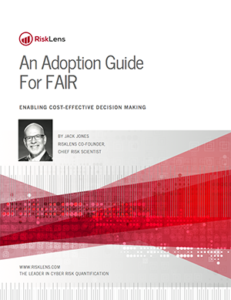Via RiskLens

Measuring and Managing Information Risk: A FAIR Approach
Factor Analysis of Information Risk (FAIR), a powerful methodology for assessing and quantifying information risks. Here’s a comprehensive overview:
1. What Is FAIR?
a. FAIR, short for Factor Analysis of Information Risk, is a quantitative risk quantification methodology designed to help businesses evaluate information risks.
b. It stands out as the only international standard quantitative model framework that addresses both operational risk and information security.
c. Mature organizations that utilize Integrated Risk Management (IRM) solutions significantly benefit from FAIR.
2. Objective of FAIR:
a. The primary goal of FAIR is to support existing frameworks and enhance risk management strategies within organizations.
b. Unlike cybersecurity frameworks (such as NIST CSF), FAIR is not a standalone framework. Instead, it complements other industry-standard frameworks like NIST, ISO 2700x, and more.
c. As organizations shift from a compliance-based approach to a risk-based approach, they need a quantitative risk methodology to support this transition.
3. How FAIR Differs from Legacy Risk Quantification Methods:
a. FAIR is not a black-box approach like traditional penetration testing. Instead, it operates as a “glass-box” method.
b. Legacy methods focus on penetration testing without internal knowledge of the target system. While they identify vulnerabilities, they cannot provide the financial impact of risks.
c. In contrast, FAIR translates an organization’s loss exposure into financial terms, enabling better communication between technical teams and non-technical leaders.
d. FAIR provides insights into how metrics were derived, allowing Chief Information Security Officers (CISOs) to present detailed information to board members and executives.
4. Benefits of FAIR:
a. Financial Context: FAIR expresses risks in dollars and cents, making it easier for decision-makers to understand.
b. Risk Gap Identification: FAIR helps organizations efficiently allocate resources to address risk gaps.
c. Threat Level Scaling: Unlike other frameworks, FAIR scales threat levels effectively.
d. Board Engagement: FAIR fosters interest in cybersecurity among board members and non-technical leaders.
5. Drawbacks of FAIR:
a. Complexity: FAIR lacks specific, well-defined documentation of its methods.
b. Complementary Methodology: FAIR is not an independent risk assessment tool; it complements other frameworks.
c. Probability-Based: While FAIR’s probabilities are not baseless, they may not be entirely accurate due to the unique nature of cyber-attacks and their impact.
In summary, FAIR revolutionizes risk analysis by providing a quantitative, financially oriented perspective on information risk. It bridges the gap between technical and non-technical stakeholders, enabling better risk management decisions.
InfoSec services | InfoSec books | Follow our blog | DISC llc is listed on The vCISO Directory | ISO 27k Chat bot







